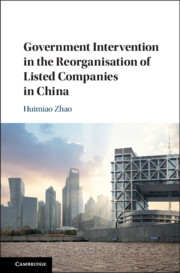Book contents
- Government Intervention in the Reorganisation of Listed Companies in China
- Government Intervention in the Reorganisation of Listed Companies in China
- Copyright page
- Dedication
- Contents
- Figures
- Tables
- Acknowledgements
- Abbreviations
- Reviews
- 1 Introduction to the Research
- 2 The Legislative Goals of the Enterprise Bankruptcy Law of the PRC
- 3 The Role of the Government in the 1986 EBL and 2006 EBL
- 4 Administrative Goals and Means of Government Intervention
- 5 Negative Impacts Exerted by Government Intervention on Bankruptcy Institutions
- 6 Balancing the Roles of Different Institutions for the Future Reform of China’s Bankruptcy Market
- Conclusion
- Appendices
- Bibliography
- Index
5 - Negative Impacts Exerted by Government Intervention on Bankruptcy Institutions
Published online by Cambridge University Press: 20 December 2019
- Government Intervention in the Reorganisation of Listed Companies in China
- Government Intervention in the Reorganisation of Listed Companies in China
- Copyright page
- Dedication
- Contents
- Figures
- Tables
- Acknowledgements
- Abbreviations
- Reviews
- 1 Introduction to the Research
- 2 The Legislative Goals of the Enterprise Bankruptcy Law of the PRC
- 3 The Role of the Government in the 1986 EBL and 2006 EBL
- 4 Administrative Goals and Means of Government Intervention
- 5 Negative Impacts Exerted by Government Intervention on Bankruptcy Institutions
- 6 Balancing the Roles of Different Institutions for the Future Reform of China’s Bankruptcy Market
- Conclusion
- Appendices
- Bibliography
- Index
Summary
This chapter examines the negative influence of government intervention on the bankruptcy institutions, including the administrator mechanism, the creditors’ meetings and committees and the people’s courts. The 2006 EBL establishes a new administrator mechanism, strengthens the power of creditors’ meetings and committees, and entrusts the people’s court with cram down power to confirm reorganisation plans rejected by creditors. In practice, however, liquidation-group administrators dominate the reorganisation of listed companies. The creditors’ meetings and committees are rather weak and cannot check and supervise the liquidation-group administrator. The people’s courts cannot make independent rulings on cramming down reorganisation plans rejected by creditors. The government intervention, moreover, results in unfair preferential treatment to large shareholders while leaving the creditors inadequately protected. As to the listed companies, many do not gain going-concern ability after their reorganisation. They encounter great difficulties in finishing their asset restructuring, unduly squandering market resources. In short, the government intervention renders these bankruptcy institutions weak and cannot function as expected by the lawmakers. It frustrates the realisation of the goals of the reorganisation system in China. The author argues that the government should return the powers to the bankruptcy institutions to let them serve a better function in China’s market.
Keywords
- Type
- Chapter
- Information
- Publisher: Cambridge University PressPrint publication year: 2020



